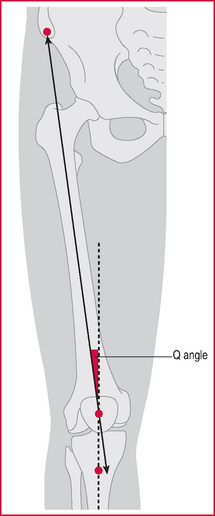Q
Q (quadriceps)-angle the angle between the long axis of the femur (and thus the line of pull of the quadriceps) and the line of the patellar tendon (extended upwards); describes the extent to which the line of pull is not straight. In practice, it is measured as the angle between the line from the anterior iliac spine to the centre of the patella, and the line from there to the tibial tubercle. Normally less than 20° (14° in males, 17° in females) but often greater in some female runners who have a wider than average pelvis. Factors which increase the Q-angle include genu valgum (knock knees), patellar subluxation, weak quadriceps, tight hamstrings and overpronated feet. Relevant in the diagnosis of patello femoral pain and used in treatment as an indication of relative quads strength, allowing appropriate strength work. See fig overleaf.
quadriceps femoris (commonly known as quads) muscle group on the front of the thigh comprising lateral, intermediate and medial vasti (all contributing to knee extension, with origin from the shaft of the femur) and rectus femoris (contributing also to hip flexion, by its origin from the ilium of the pelvis). Parts of the vasti are inserted into the top and sides of the patella, and contribute tendinous reinforcements to the joint capsule of the knee. The four muscles converge onto the single quadriceps tendon which spans the front of the knee to be inserted as the patellar tendon (ligament) into the tibial tubercle (tuberosity). See also patella, Q(quadriceps)-angle.
< div class='tao-gold-member'>









